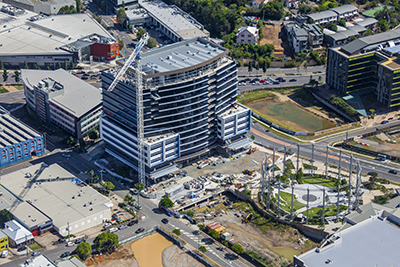100 Skyring transforms Gasworks’ gateway to Brisbane
EXTRA >>
THE BUILDING had not even reached completion when the accolades began for its innovative approach to commercial and retail property.
Charter Hall’s $175 million 100 Skyring has already created a prominent gateway to the Gasworks precinct, heralding the continued evolution of Brisbane’s near city office market. 
Boasting a striking exterior, the 12-storey building on Newstead’s Skyring Terrace, has been designed to foster greater staff collaboration and productivity with large, campus-style floor plates.
Charter Hall regional asset manager, Belinda Kalinin said 100 Skyring responded to the growing demand for buildings that fostered “a greater work-life balance”.
“An inspiring workplace design and environment encourages employee performance, motivation and satisfaction,” Ms Kalinin said.
“100 Skyring’s 2,200sqm floor plates have been orientated to maximise natural light and allow for ultimate workspace planning flexibility to increase interaction, efficiency and collaboration.
“With the Brisbane River and Gasworks’ new dining, lifestyle and entertainment precinct on its doorstep, 100 Skyring also creates space for tenants to work and play.
“With work increasingly being conducted outside of traditional office hours, businesses are looking for locations that make it easy to achieve this work-life balance. 100 Skyring has been designed to connect and engage with the precinct’s open green space, cafés, restaurants and other amenities, extending the workspace outdoors.”
ML Designs senior project manager Paul Hanley said they designed 100 Skyring’s exterior so that it was a captivating focal point for people travelling along Breakfast Creek Road towards the city.
“A key feature of 100 Skyring is its 206m-long artwork that wraps around the two-level podium carpark floors. This artistic screen runs along three sides of the building and consists of approximately 2,000 interlocked, metallic panels,” Mr Hanley said.
“Apart from giving the building greater texture and visual interest, these ‘scales’ cleverly screen the building’s podium carpark. It’s an innovative solution that delivers a stunning talking point.”
Renowned Brisbane artist Daniel Templeman designed the piece and drew inspiration from the illumination of the neighbouring historic Gasometer frame and city streets. It connects and contrasts the site’s industrial past to the contemporary reinvigoration symbolised by 100 Skyring.
Mr Templeman’s striking sculptural outdoor installations are showcased across Australia, from the Brisbane Magistrates Court and Macquarie University, to Central Plaza 3 and Tugan Bypass.
“100 Skyring’s design also allows for tenants on all floors to have an amazing view of the Brisbane River and beyond thanks to an east-facing, gently-curved façade,” Mr Hanley said.
“This also allows the building to prominently front the neighbouring Gasometer with its green public plaza.”
Fronting both Skyring Terrace and Longland Street, 100 Skyring is expected to reach practical completion this month (August) with office space still available for lease.
ends

 How to resolve AdBlock issue?
How to resolve AdBlock issue? 




